Gainesville unveils

La Catrina art
Dealing with cold damage
Conservatories get upgrades


Gainesville unveils

La Catrina art
Dealing with cold damage
Conservatories get upgrades

Years ago, I took a lovely walk with one of Atlanta’s community leaders, a very thoughtful and strategic thinker who loves this city dearly. As we stood on the Canopy Walk admiring the new Gardens in Storza Woods, he said something that would forever change the Garden’s future. His simple statement was, “If there were ever a time to expand the Garden and Piedmont Park, it is now – before it’s too late.” We were looking north, the only direction that might offer expansion opportunities. That statement stayed with me for weeks, and I finally began looking at Google maps to see where such a vision might occur.
Now, almost seven years later, that idea is about to become a reality. And while a Garden expansion is a worthy dream, it’s what comes with it – a new door on the Atlanta Beltline – that truly makes this expansion so compelling (see pages 8-11). Imagine our city in the future with a 22-mile continuous loop for walking and biking. It will be a recreational corridor as well as a means to move through the city without a car, with millions of people connected to the city and its neighborhoods using their own energy. This transformational expansion will enable the Garden to welcome members and guests in the most sustainable way imaginable.
As with any visionary and challenging project, there are many “heroes” who have worked with us to move forward. Three mayors, multiple city council members, board members and thoughtful community leaders have quietly helped us propel this expansion. There truly are too many to name, but they will forever be the visionary founders of the Garden’s expansion.


The James M. Cox Foundation was the first to embrace the vision, providing a tremendous lead gift of $25 million to launch the land acquisition campaign. The foundation shares our vision for a new sustainable entrance for the Garden and creating a cultural destination on the Beltline. We are eternally grateful to the foundation and its board. And we treasure our former Lifetime Trustee, Anne Cox Chambers, whom we lost in 2020.
Carol Tomé, former chair of the Garden’s Board of Trustees, also joined us early in this acquisition campaign by agreeing to serve as its chair and providing a generous gift of $5 million to launch us forward. UPS, Atlanta’s hometown company, followed with a matching gift of $5 million to assure that the expansion would be successful. UPS is truly a visionary company that shares the Garden’s commitment to sustainability and a healthy planet.
We have a long way to go, but landscape designs are under way as we strive to create a garden addition on a grand scale that showcases floral displays, horticultural treasures and the integration of water and art. Our design is bold, reflecting inspiration from timeless European gardens while showcasing a contemporary Atlanta garden.
Mayor Andre Dickens has challenged us to open the addition in time for the World Cup to be held in Atlanta in July 2026. That’s a formidable challenge but one that we will strive to achieve. As Atlanta steps into the international limelight, so, too, will the new Atlanta Botanical Garden.

At first glance, they look a bit ominous, just from their sheer size. On closer look, their faces exhibit compassion, concern and ingenuity.
The six massive young trolls hanging out in the Garden are on a mission to protect its guests from old grumpy trolls who have had it with the human race. The young activists – represented by sculptures made of all reclaimed materials – are “in a fight with humanity about how to behave in the natural world. The old trolls in my stories want to eat the humans because the humans are messing up the world,” the trolls’ creator, artist and storyteller Thomas Dambo, said in a recent interview.
But in his current exhibition Trolls: Save the Humans the young guys and girls are determined to instead teach folks a lesson: That it is time to wake up and save the planet – before it’s too late.
The traveling folklore-inspired sculptures, some up to 15 feet tall and 25 feet wide, are making their world premiere at the Garden through September 17 in an exhibition delighting guests of all ages. The whimsical trolls highlight Dambo’s passion as a recycling art activist whose mission is to inspire people to explore and create new adventures in nature while demonstrating that trash can be turned into something beautiful and unique.

In this new exhibit the Danish artist tells an evolving story of listening and tending to nature, further building on the Nordicinspired tales and artist-made poems surrounding his many other larger-than-life trolls that co-exist in locations around the world.
Presented by Imagine Exhibitions in collaboration with the artist, Trolls: Save the Humans is the latest chapter in a worldwide sculpture fairytale written by Dambo. In this case, the six young trolls have noticed that humans are disconnected from nature and have started harming the planet. The trolls set out to help humans learn how to live in harmony with the planet. Full of personality and activism, each troll has a name and plays a distinctive role in the tribe, becoming role models for humans to learn from.
Born in Denmark to hippie parents, Dambo’s
With diverse personas, sculptures deliver a message of sustainability
mission is to create art that inspires people to explore, have adventures in nature and show that recycled goods can be turned into something beautiful. Before building sculptures, the artist, 43, led a multi-faceted life that allowed him to express his creativity via music, street art and scenic design.
Dambo began creating wooden trolls about 10 years ago, and as word of his unusual work spread, he was invited to travel and create installations around the world, which now number about 100.


For the Garden’s exhibit, he and his crew of about 21 gathered the reclaimed materials in Denmark, where they built the trolls, then broke them down for shipping and reassembling in Atlanta.

“I hope that people will learn something about nature and sustainability,” Dambo told The Atlanta Journal-Constitution. “When I was a child I looked at a dumpster and saw a beautiful thing that I could use to change the world. The world is limited, and if we keep changing the world into a big landfill then we will run out of room, and we will all just live in a big landfill.”
Trolls: Save the Humans by Thomas Dambo is presented with support from the Isdell Family Foundation.
MEET ARTIST THOMAS DAMBO during a free Alston Lecture on “Trash, Trolls and Treasure Hunts” at the Garden on Tuesday, June 13 at 7 p.m. A book signing follows. Dambo’s journey is a real-life fairytale about how he roamed his home city of Copenhagen on a cargo bike for dumpster diving materials
STORZA WOODS: Basse spreads his message in mud paint and
An introvert, this troll is a listener who pays great attention to the little things. He was the first one to notice that something is wrong with the world and that nature is changing for the worse. He listens to the earth.
SOURWOOD TERRACE: An introverted troll, she expresses herself through her care for plants using her life-giving fingers. She spreads her wisdom by showing how plants can make even the most useless items come back to life.
ANNE COX CHAMBERS GARDEN: This optimist tries to communicate with humans through colorful birdhouses. She’s observed how humans build these structures to bring wildlife closer to them so thinks more birdhouses could awaken humans’ compassion for their natural surroundings.
ALSTON OVERLOOK: Where humans see trash, Kamma sees potential and wants to teach the humans not to throw away things so fast but instead to get creative, such as using colorful plastics to create necklaces for the other trolls in the tribe.
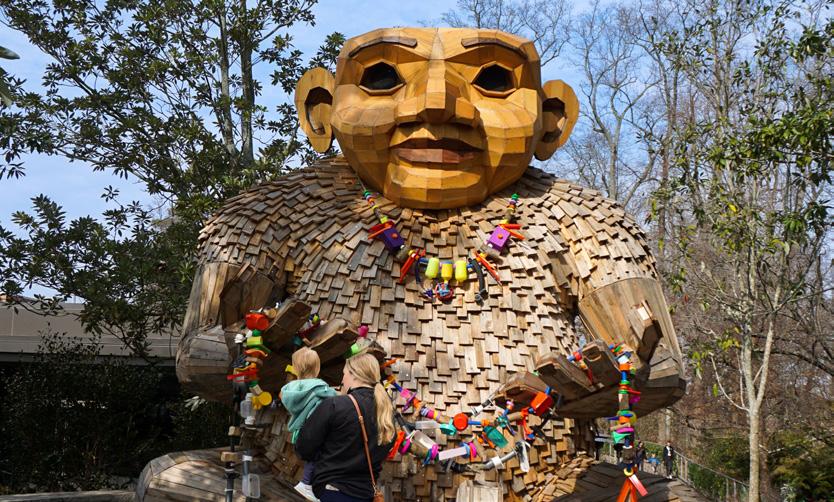
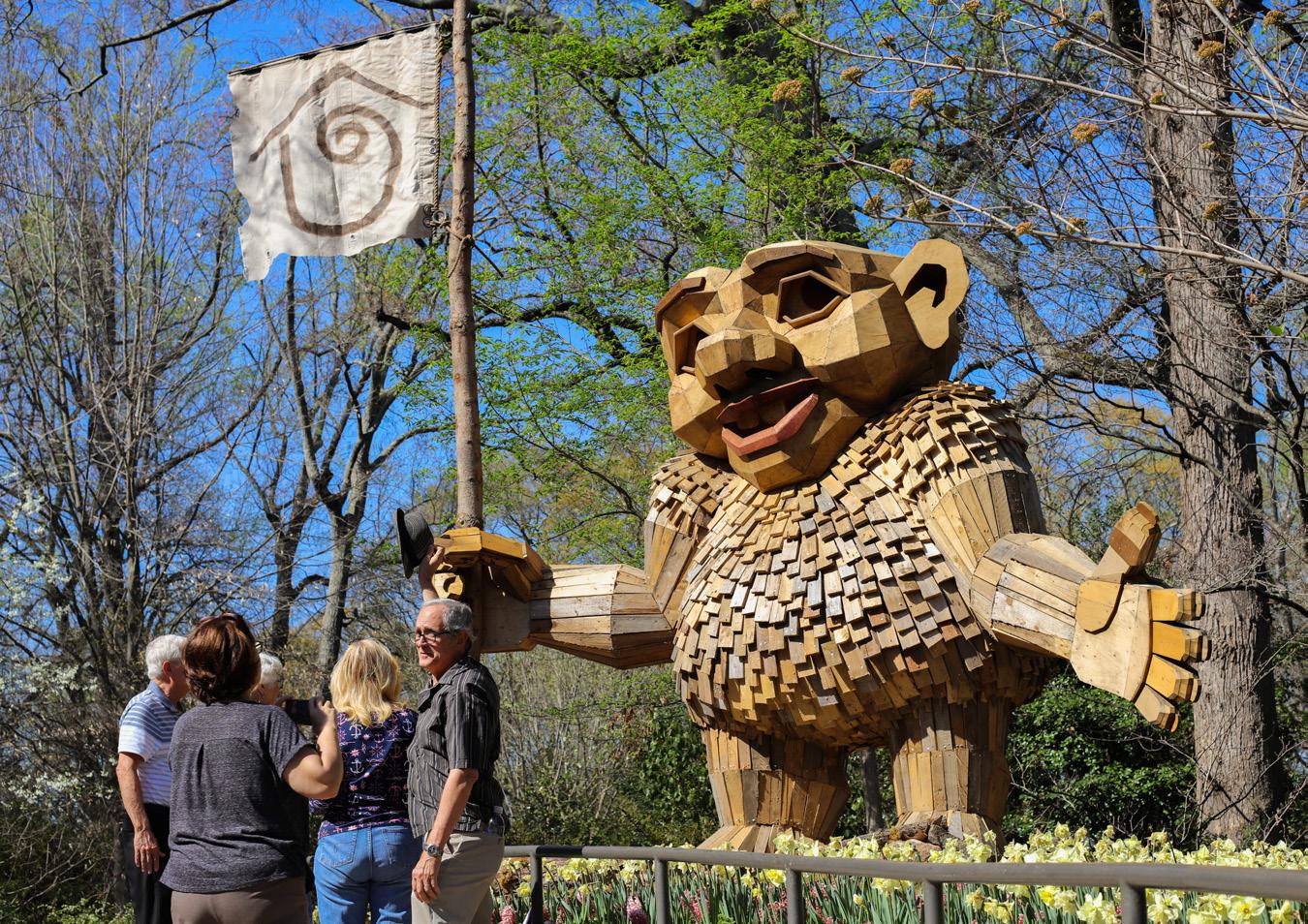
Considered the best communicator among the troll tribe, Ronja speaks to humans with compassion because she knows that words have the power to make them smile but can also make them sad.

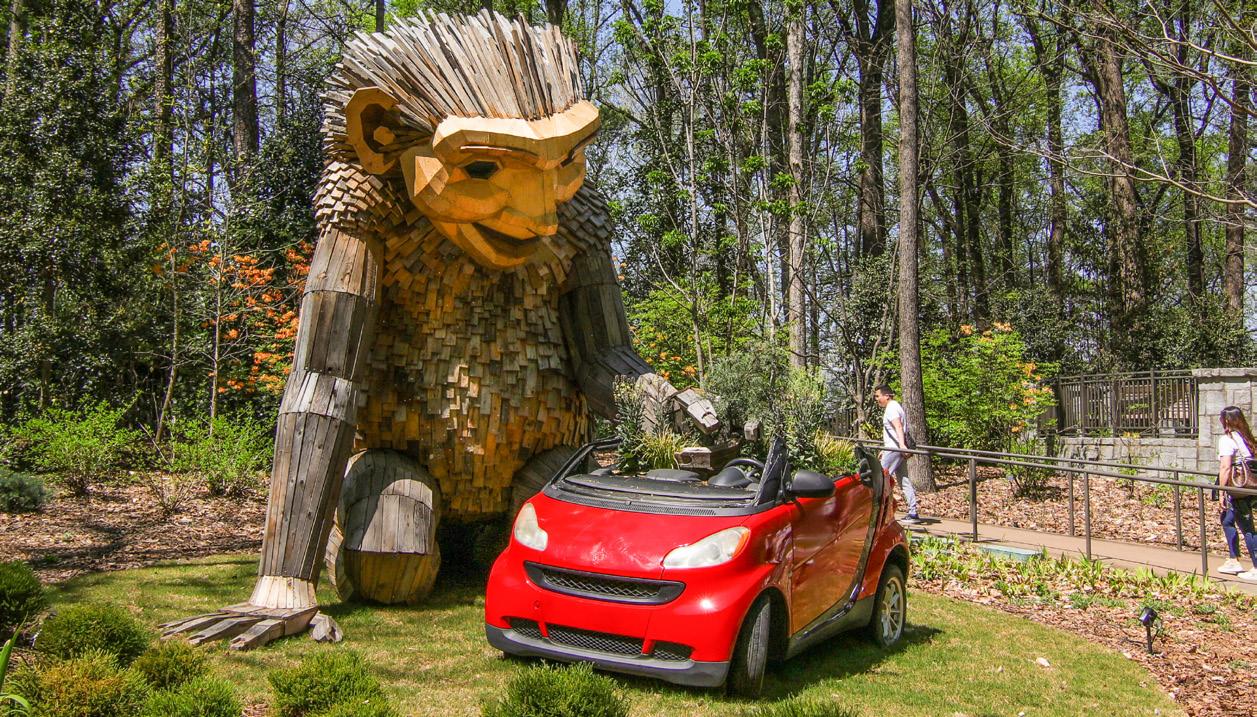

Part of the fun of gardening is taking stock each year of what worked and what didn’t, and either choosing new plants for the coming spring or rearranging existing ones. Sometimes plants don’t thrive because of too much or too little sun or water – or a 35-degree plunge into single-digit temperatures over several days as occurred last December.
Garden horticulturists can’t cover everything for protection, so a selection of manageable-sized plants were selected because of their importance to the collection. They were wrapped with a special cloth designed to keep plants warmer than the ambient temperature. Then the waiting game began. What would survive? And what would only be damaged but make a full recovery?
This spring revealed that a few small covered palms survived, but some larger ones appear to be in decline. A few small covered conifers were OK, but some hardiness trials like Fokienia didn’t make it, and for some larger Cryptomeria japonica cultivars staff are still hoping to see new buds break. Loquats have brown
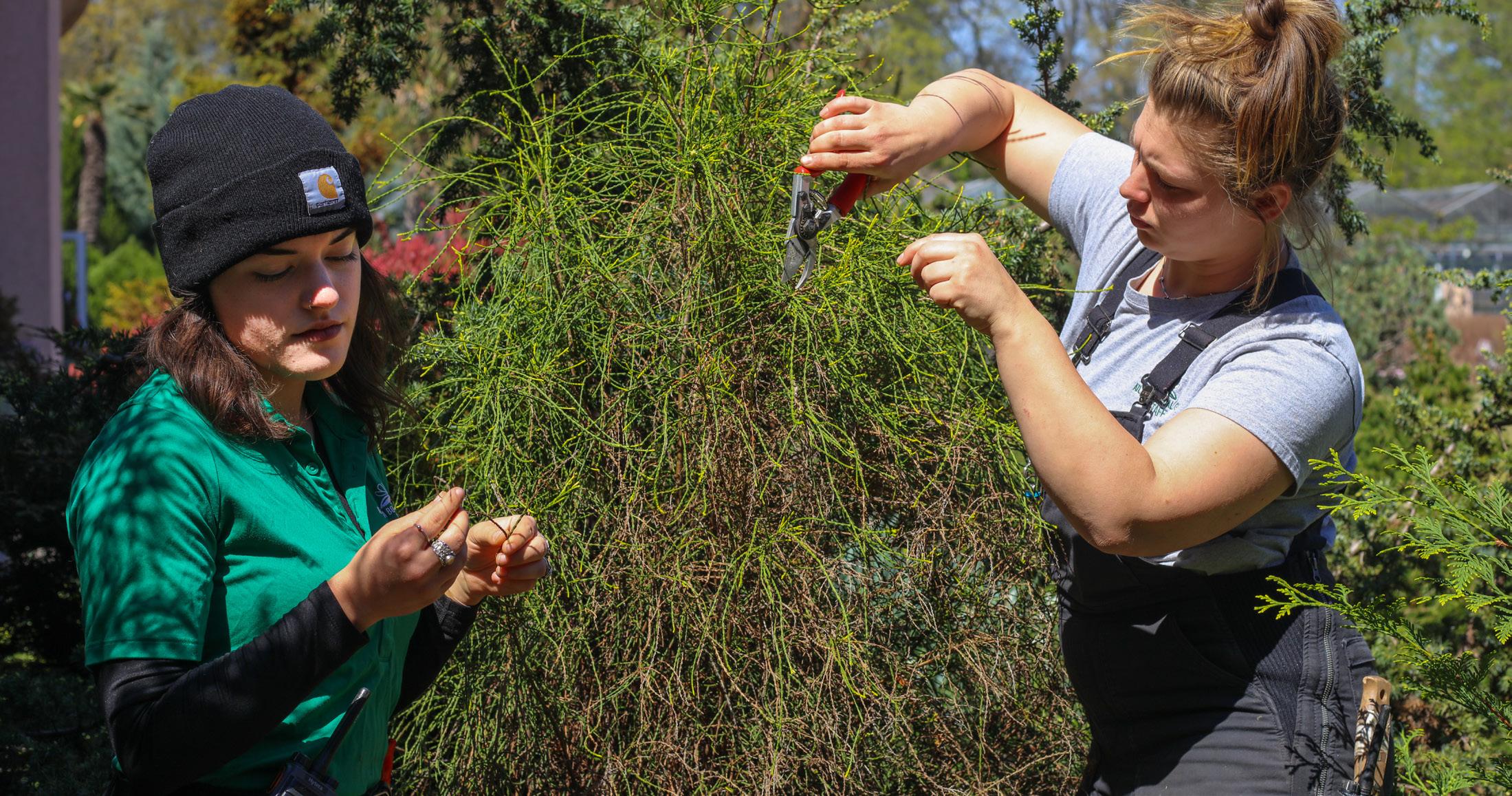
leaves, but new growth is starting to emerge. Tea olives mostly lost their leaves but are flushing back out. Even jasmines are still piles of brown but with hints of green. For those evergreens long overdue for a haircut, the damage provided a golden opportunity to make cuts that will quickly be covered by the verdant green for which the plants are known.
One area of particular concern has been the Skyline Garden. Its cactus and succulent terraces opened in 2017 with a collection of hardy cacti, succulents and companions carefully curated with in-depth knowledge of these particular plants but also room to experiment with new ones because of the microclimate created by the Corten steel raised beds, enhanced drainage and engineered soil. Echinocactus grusonii, golden barrel cactus, were covered with the fabric and black pots placed on top of them. But for the rest it’s been a waiting game because some plants can take weeks or months to fully show damage.
It quickly became apparent that most
trial cultivars of X Mangave, which at best are borderline hardy in Atlanta, didn’t make it. Agave americana hybrids proved hard hit. But other Agaves like A. ovatifolia, A. bracteosa and A. havardiana look no worse for the wear. Still, some cacti are keeping staff on their toes, like the uniquely shaped Opuntia scheeri, as they wait to see if cutbacks are well taken or if it just rots out.
When Mother Nature throws a curveball, a garden hard hit by winter is an excuse to shop. Change is a part of gardens. Lists are currently being made for replacements – some plants will be exactly what was there, some will be old friends not grown in a while, and some will be new plants staff are excited to try. Like most gardens, this changing landscape is never finished.
Amanda Bennett Vice President, Horticulture & Collections Samantha Gader and Madison Ruth HorticulturistsIn the heart of the 30-acre Garden, unique plants from distant corners of the planet have thrived for more than three decades, on display year-round in two special glass-house facilities.
The Dorothy Chapman Fuqua Conservatory opened to wide acclaim in 1989, and in 2002 the addition of the Fuqua Orchid Center made it possible for visitors to explore the largest collection of species orchids on permanent display in the United States. Both destinations were built with transformational gifts from the J.B. Fuqua family – and now both are benefiting from recent grants totaling $1 million from the J.B. Fuqua Foundation and the Realan Foundation.
A series of grant-funded capital improvements is under way to help keep these beloved buildings in tip-top shape. Seemingly tranquil to visitors, the facilities hum with technology 24 hours a day. It is no small feat to maintain ideal tropical and desert growing conditions in Atlanta’s climate, requiring ingenious systems to gauge, track and adjust for fluctuations in temperature, humidity and climate with every pass through the door. A vast array of interconnected equipment is being replaced, refurbished
and upgraded as needed to match current and future technologies.
“We are so grateful that Dottie and J.B. Fuqua recognized the importance of con structing state-of-the-art facilities that truly put Atlanta on the map. They were responsible for catapulting us to the top tier of botan ical gardens worldwide,” said Garden President & CEO Mary Pat Matheson. “Thanks to the exceptional generosity of the J.B. Fuqua Foundation and the Realan Foundation, our gardens under glass continue to delight more than 750,000 guests annually while helping advance our important work studying and safeguarding global biodiversity.”
A few iconic plants must grace every garden in the Southeast, and gardenias arguably rank among the top of that list. Fortunately, for those craving the sweet fragrance of springtime, several types of gardenias can thrive indoors.
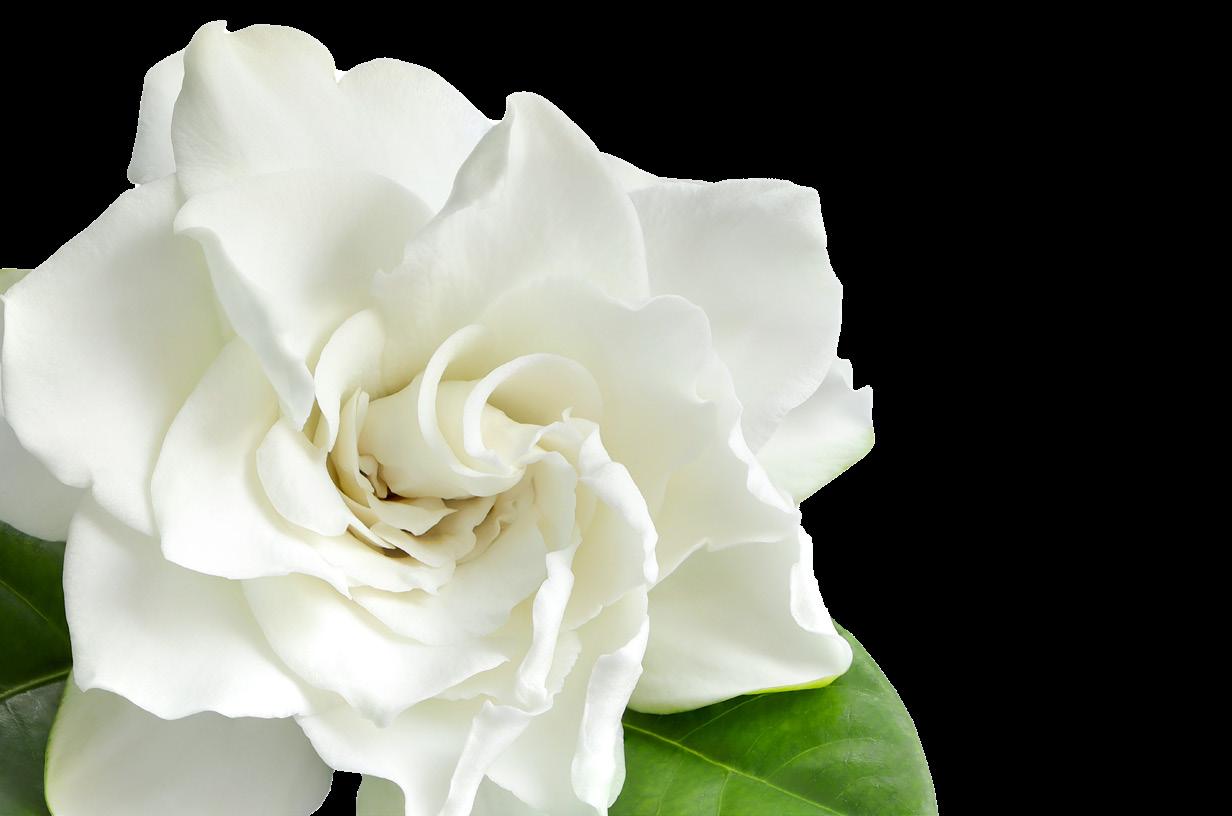
Members of the Coffee family (Rubiaceae), gardenias are native
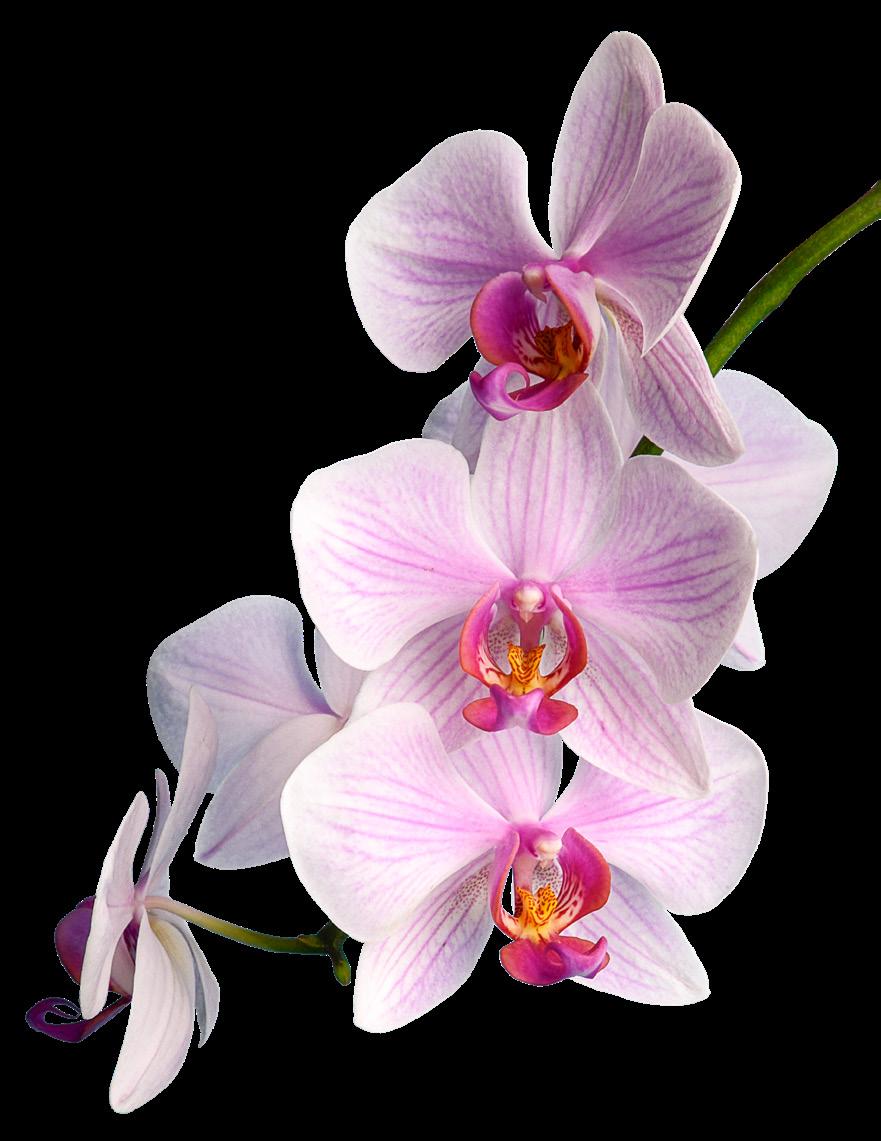
to the subtropical regions of Africa, Asia, Madagascar, the Pacific Islands and Australia. The genus Gardenia was named in 1762 after Scottish physician and botanist Alexander Garden, who immigrated in 1754 to Charleston, S.C., where he established his estate and garden. In 1766 he planted Gardenia jasminoides, commonly known as “Cape Gardenia” because it came from China via Cape Colony, South Africa.
Among Gardenia’s 140 species, only a handful are used in horticulture, with Gardenia jasminoides the most important in the Southeastern landscape. Evidence suggests that this species was cultivated for its fragrance and dyes by the Imperial Song Dynasty of China (980-1279 AD). Since its introduction to the United States, plant breeders have developed more than 400 varieties ranging in size from 2 to 12 feet tall, with single and double flowers that are white, cream to golden yellow in color. All are highly fragrant and tolerate hot summers and cold winters.
Generally, most varieties grow well in
the Southeast (hardiness zones 8 - 11) although a few hardy varieties can survive to zone 7, such as ‘Pinwheel’, ‘Celestial Star’, ‘Frostproof’ and ‘Jubilation’. For small gardens and containers, dwarf varieties such as ‘Buttons’, ‘Raddicans’, ‘Crown Jewel’ and ‘Kleims Hardy’ are available. Among yellow- to gold-flowering varieties choose ‘Golden Magic’ and ‘Aurea’, and for varieties with the largest flowers, consider ‘Aimee Yoshioka’, ‘Fortuniana’ and ‘Belmont’, which can produce blooms 4 to 6 inches in diameter.
For those with a greenhouse or warm solarium, several gardenia species can be grown indoors. Originating from tropical regions, the most famous is the Tahitian Gardenia, Gardenia taitensis, from Polynesia used to make the fragrant hair oil “Monoi de Tahiti” and the lei necklaces of Hawaii. Others include Gardenia nitida, G. posoqueriodes and G. imperialis from Africa, G. aubryi from New Caledonia and the rare but golden-flowered G. tubifera from Southeast Asia, all of which grow in the Fuqua Conservatory.
Paul Blackmore Conservatory & Conservation , Display Garden ManagerTropical fragrant gardenias can be enjoyed indoors

Garden’s bold vision for expansion includes second entrance along Atlanta Beltline

standing at the northern edge of Storza Woods and soaking up a view of pools of water flowing along a grade gradually descending 45 feet to a Garden entrance along the popular Atlanta Beltline.
Or conversely, after biking the Beltline you pull into an inviting courtyard for a cold one at a beer garden before ascending a winding tapestry of garden terraces to a lush, tropical orangerie.
Those bold, enticing dreams could blossom into reality with the Garden’s planned expansion of nearly 8 acres that will abut the Beltline, allowing for a second entrance for pedestrians and cyclists, and thus reducing reliance on automobiles as the city’s population continues to grow.
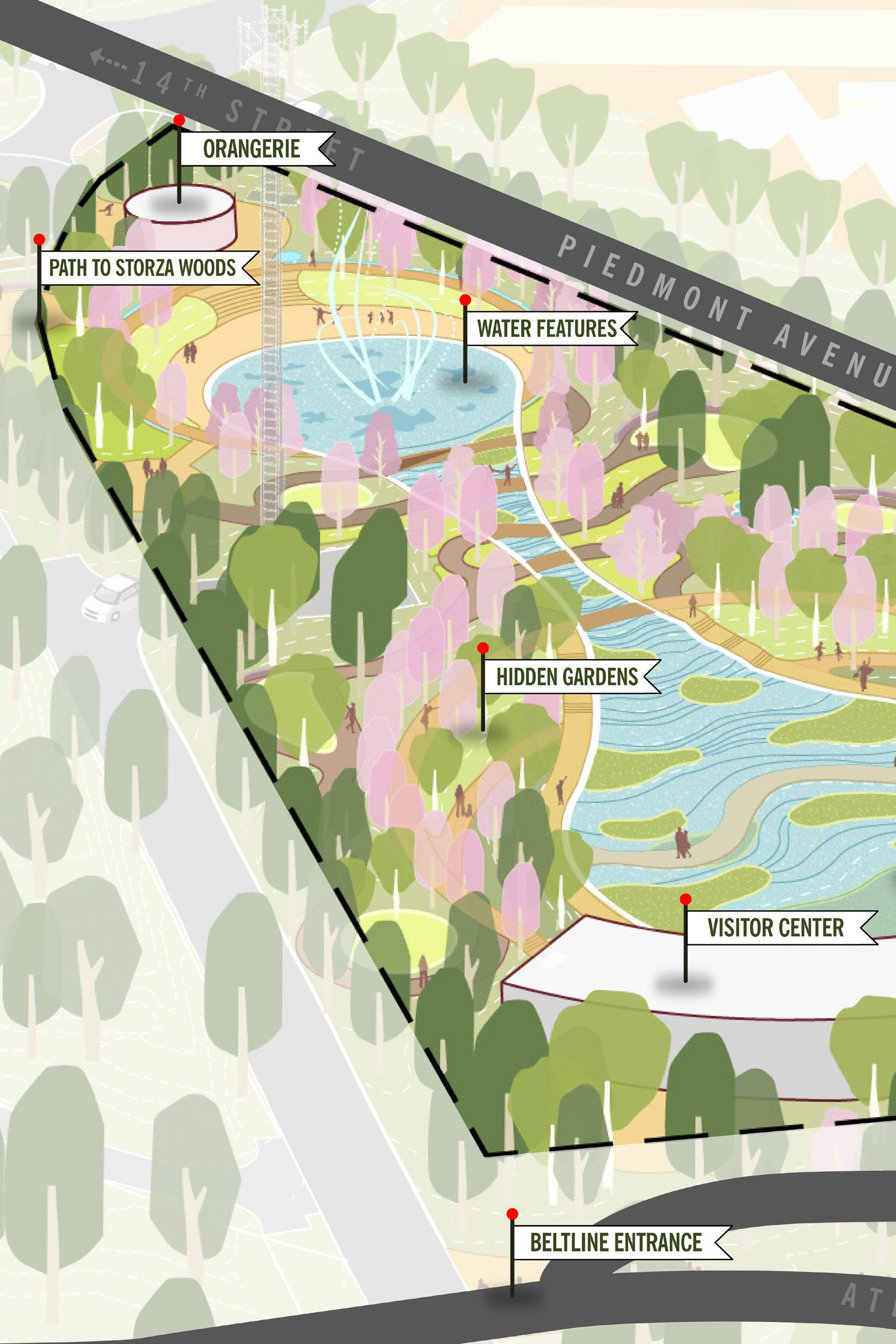
The addition also would make the Garden Atlanta’s only cultural attraction directly accessible from the 22-mile loop of abandoned railroad corridors encircling the city, one of the country’s most popular ongoing urban revitalization projects.
“Once it’s complete, I think this expansion will be to the Beltline what The Whitney Museum is to New York City’s High Line,” said Mary Pat Matheson, the Garden’s President & CEO. “And that’s because we plan to bring our pioneering spirit to this new part of the Garden, combining art, water and gardens in compelling and beautiful displays.”
The Garden expects site work for the project, which is still in the early planning and land-acquisition phase, would begin within the next two years with a targeted completion of late 2026.
Expansion efforts began in 2018 when the City of Atlanta invested $20.4 million in the acquisition of retail and mixed-use property near Piedmont Avenue and Monroe Drive and earmarked that land for future expansion of neighboring Piedmont Park. Since then, the Garden has purchased several commercial parcels along Piedmont Avenue with private funds for its own future expansion needs. Ultimately, the dual expansions would create a convergence of three of the city’s most popular greenspaces – the Garden, the Beltline and Piedmont Park.
“The project is truly transformational as it would enable the Garden to acquire land for developing an entrance on the Beltline that is focused on the most sustainable
Design ideas being considered emphasize water and contemporary style and expected to be finalized later this
form of transportation – walking and biking,” Matheson said. “This underscores our commitment to increasing the city’s greenspace and sustainability.”
Most of the required land, which would expand the 30-acre Garden by about 25 percent, has been acquired over the last several years. Once all parcels are secured,
the Garden will launch a comprehensive campaign for developing the property. Last year, the James M. Cox Foundation awarded the Garden a lead gift of $25 million toward the project.
The Garden has hired Chicago-based Hoerr Schaudt Landscape Architects to design the expansion. “We interviewed some really good
PIEDMONT AVENUE MONROE DRIVE (Rendering overview courtesy Hoerr Schaudt Landscape Architects) EXPANSION MAP EXISTING GARDEN EXPANSION BELTLINE
emphasize grand vistas, moving and materials. Design plans are this summer. Architects)


An emphasis on water movement, with basins designed with sustainability in mind in times of drought.

Contemporary style and materials not found in the existing Garden.
Display gardens with plant collections woven among them.

Art, both temporary and permanent, such as a 20-foottall Phoenix (symbol of Atlanta) mosaiculture sculpture at the new entrance.
A grand vista inspired by European gardens that serves as the spine of the new space, extending from the Beltline entrance to Storza Woods.
An entry courtyard for welcoming guests from the Beltline and for parking bikes and scooters before entering a visitor center.
design teams, but Hoerr Schaudt showed us big, bold examples for ways to attract people off the Beltline and into the Garden,” Matheson said. “They also brought one of the nation’s best water designers to the table.”
Smith Dalia Architects of Atlanta, which has worked on several Garden projects before, has been hired to design the facilities.

“Imagine a sculpture of Phoenix, which represents our city’s endurance, rising over the Beltline to the delight of all who walk by the Garden,” Matheson said. “And envision an orangerie with plants from around the world that would welcome new Beltline friends to enjoy the bounty that the Garden has to offer.
“Let’s dream big!”
An orangerie that doubles as an event rental space.
Though still in the planning phase, the design concept tentatively is expected to feature:A contemporary beer garden and café near the entrance.
Select Wednesdays through October, 6:30 – 8:30 p.m.
Enjoy a fun evening dining, sipping and learning as favorite neighborhood chefs prepare a four-part small plate menu. Learn new recipes and taste freshly prepared courses and wine.

Through Sunday, Sept. 17
Experience an exhibition featuring six of artist Thomas Dambo’s enormous folk-lore inspired sculptures built from reclaimed materials as it makes its world premiere at the Garden.
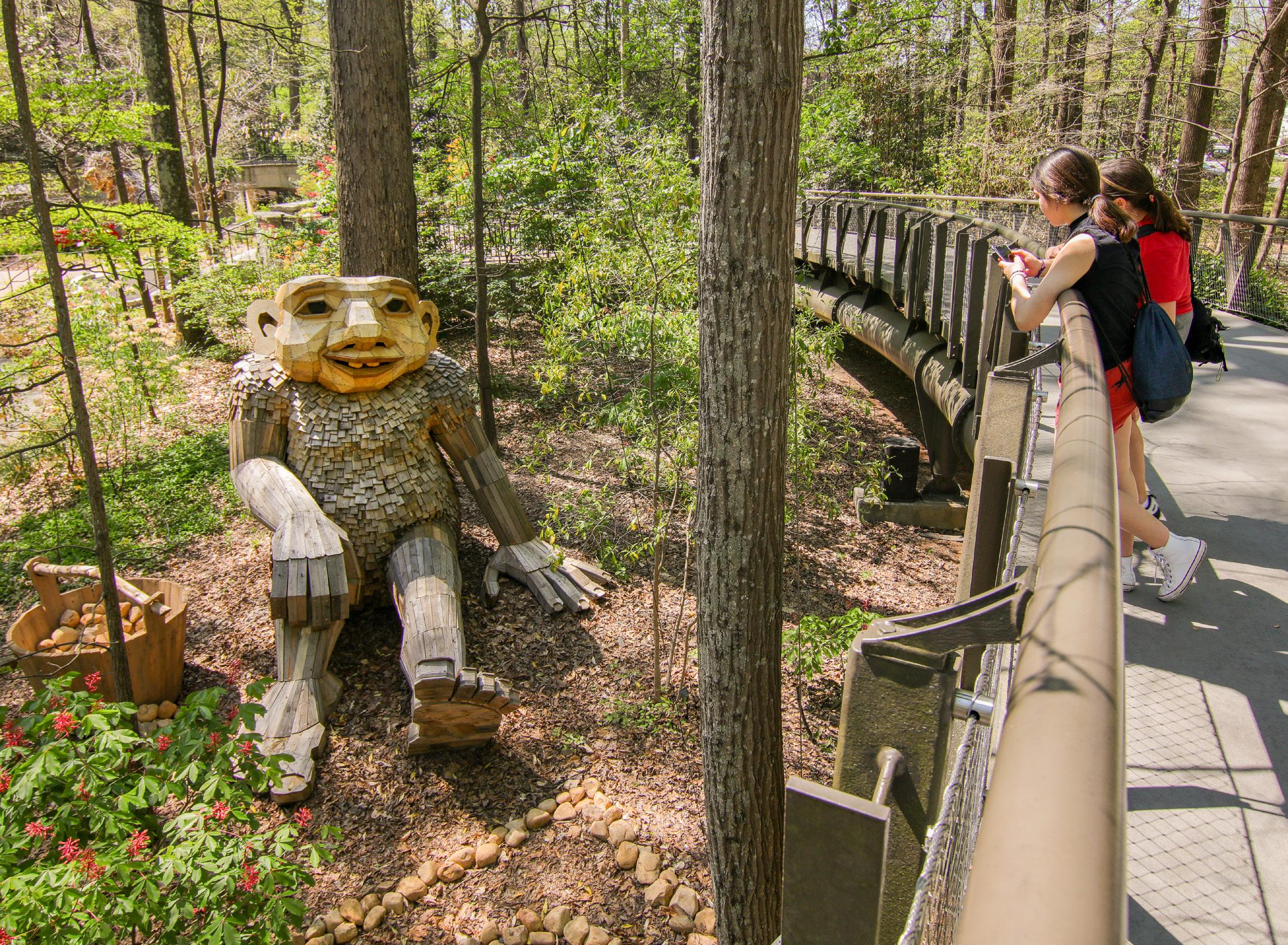
Saturdays & Sundays, May — October, noon, 1 p.m., 2 p.m.
Garden Chefs showcase fresh seasonal vegetables, fruits and herbs in tasty recipes in the Edible Garden Outdoor Kitchen.
Saturday, May 13, 1 – 5 p.m. Sunday, May 14, 10 a.m. – 5 p.m. Presented by the Greater Atlanta Rose Society, the annual cut-flower show in Day Hall features roses of every variety
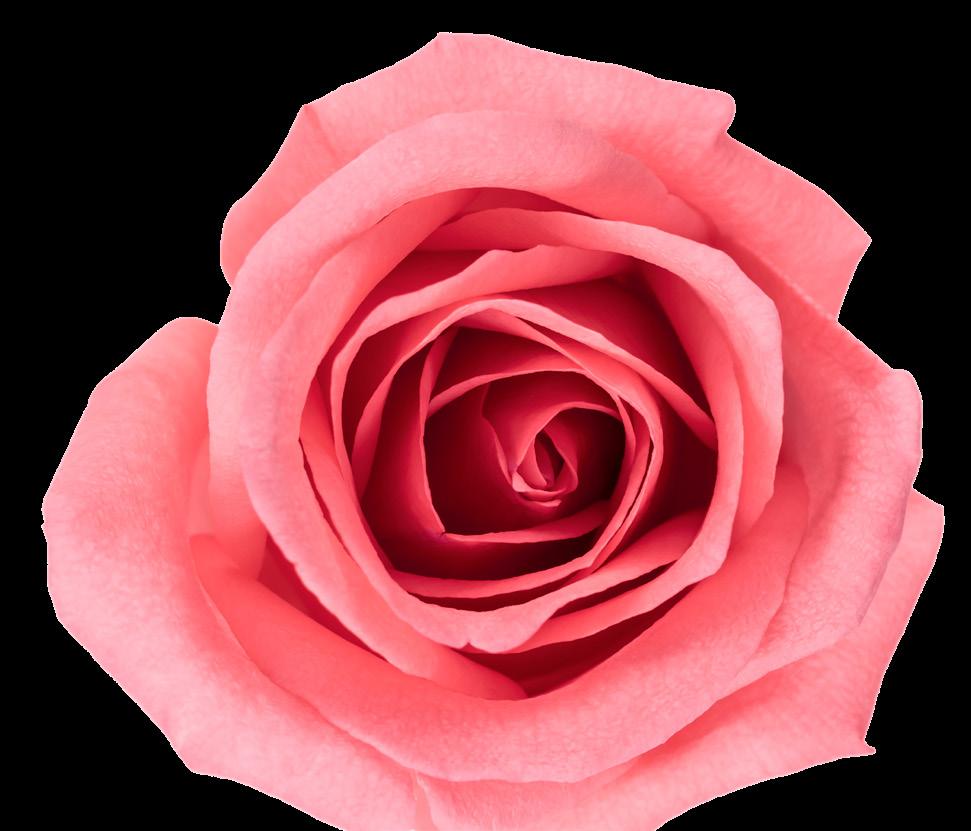
Monday, June 5, 4 – 7 p.m.
The Garden is open exclusively for individuals with cognitive and sensoryprocessing disabilities, and their families. Explore beautiful spring flowers and engage with special learning and art stations.
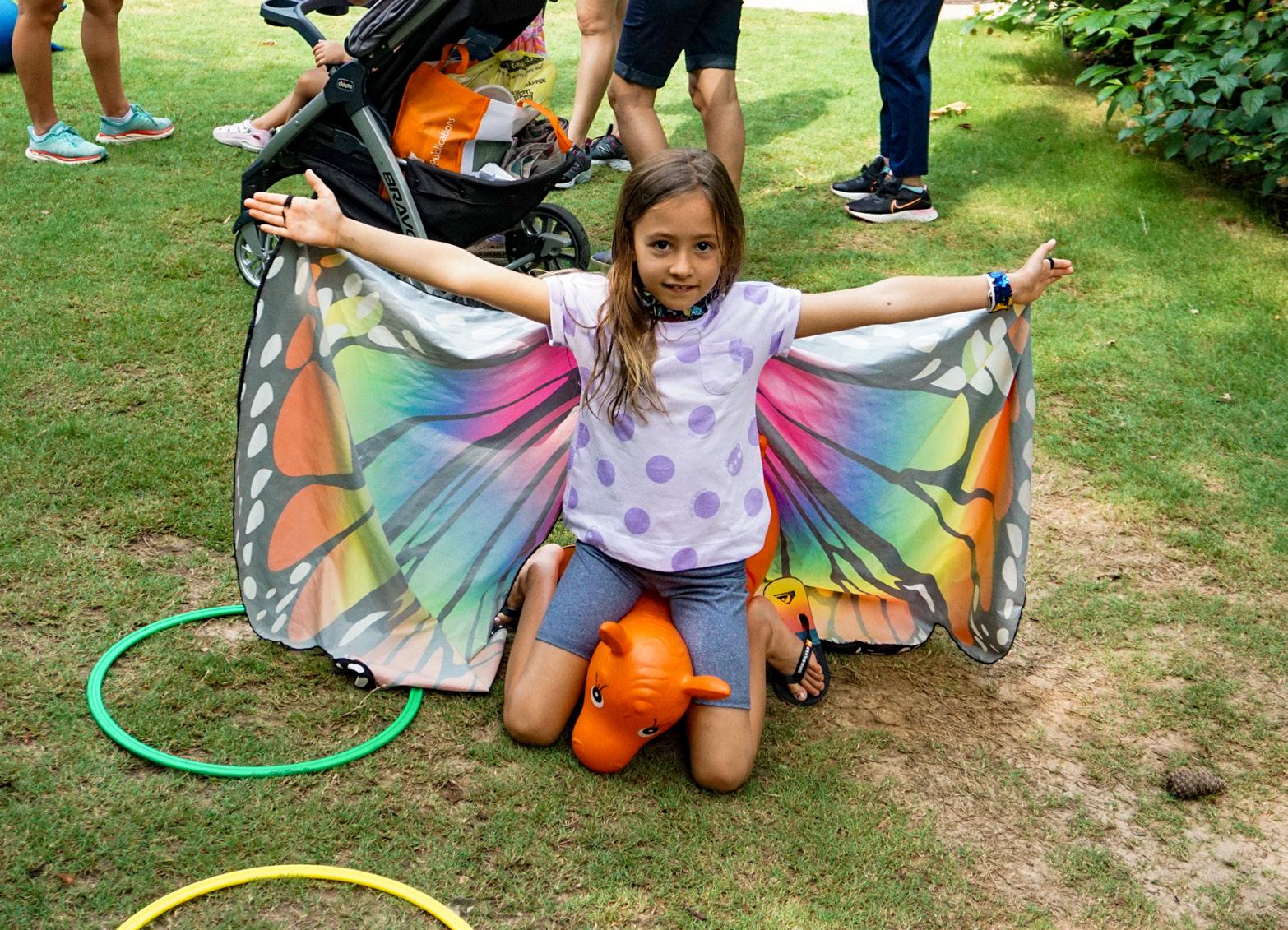
Tuesday, June 13, 7 p.m.
Presenter Thomas Dambo’s journey is a real-life fairytale about how he roamed his home city of Copenhagen on a cargo bike dumpster-diving materials for his first small installations to gaining international recognition as the world’s leading recycling artist. Learn more about Dambo and his current exhibition at the Garden, Trolls: Save the Humans, during this free lecture. The Philip and Elkin Alston Lecture Series is made possible by the generous support of the Charles Loridans Foundation.
international recipes alongside other activities that highlight Atlanta’s diverse refugee communities and foodways.
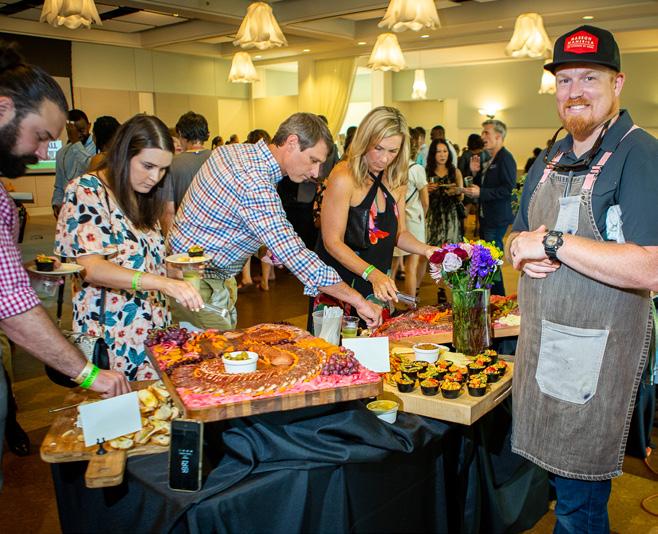
gardens. Don’t miss Alyssa Easterly’s performance of Jammin’ Junebugs at 10 and 10:45 a.m.
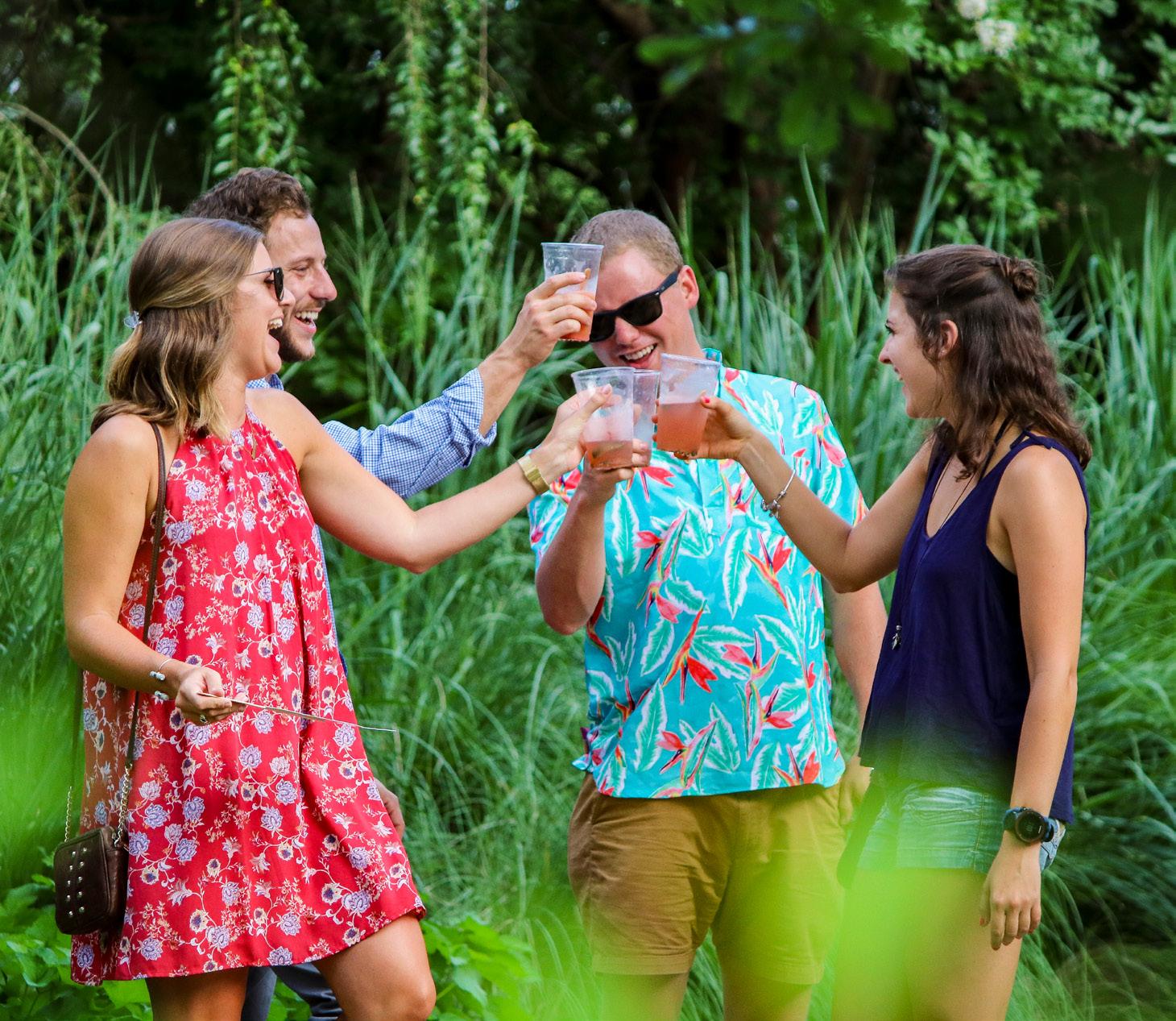
Tuesday - Sunday, 9 a.m. - 9 p.m.
2 - SEPT.
Monday, Aug. 21, 5 – 8 p.m.
AgLanta Eats, the hyper-local food festival, returns with a variety of tastings prepared by top local chefs utilizing the freshest ingredients from AgLanta growers and metro Atlanta farms. Attendees will have full access to the Garden while enjoying farm-fresh food tastings, a selection of beverages, live music and more.
Thursdays – Saturdays, May 4 – Sept. 30 , 5 – 9 p.m. Enjoy cocktails from cash bars and live entertainment while exploring the summer exhibition Trolls: Save the Humans by Thomas Dambo dramatically lit at night.
As we move into the warmer months of the year, evenings are one of the nicest times to enjoy the Garden. The light is softer, bright summer colors really pop throughout the garden, and a gentle breeze, combined with the calls of tree frogs and birds, provides a perfect respite.
I hope that you will join us for one of our Cocktails in the Garden on the first Saturday of the month from May through October. We have lined up some excellent musicians to provide a backdrop for enjoying a specialty cocktail or other refreshing beverage on the terrace. Lawn games will be available for the adventurous, and there might even be a cornhole contest as well.
Summer also will be the prime time to enjoy our new exhibit, La Calavera Catrina. Nine larger-than-life colorful sculptures can be found throughout the garden. Check out our website or Facebook page for programming for all ages associated with the show. The exhibit ends August 27, so don’t miss it!
Another fun addition this summer is Fairytale Fridays held in the Children’s Garden. Children should come dressed as their favorite fairytale character, fairy, dragon, etc. and join the Fairy Parade on Fridays at 11 a.m. After the parade, you’ll want to stick around for other activities that the kids will enjoy.
And as we move toward landscaping the new parking lot in late summer and early fall, you will also notice new plantings throughout the garden – from the entry road to the Event Lawn perennial border and other pockets in the main garden. There are always exciting new plant varieties to add to the garden to provide ideas for members and visitors.
Hope to see you in the Garden!
Mildred Fockele Gainesville Garden Director
The Gainesville Garden’s new art exhibition, La Calavera Catrina, features nine larger-than-life, colorful sculptures of La Catrina, an elegant female figure and icon of Mexican national heritage.
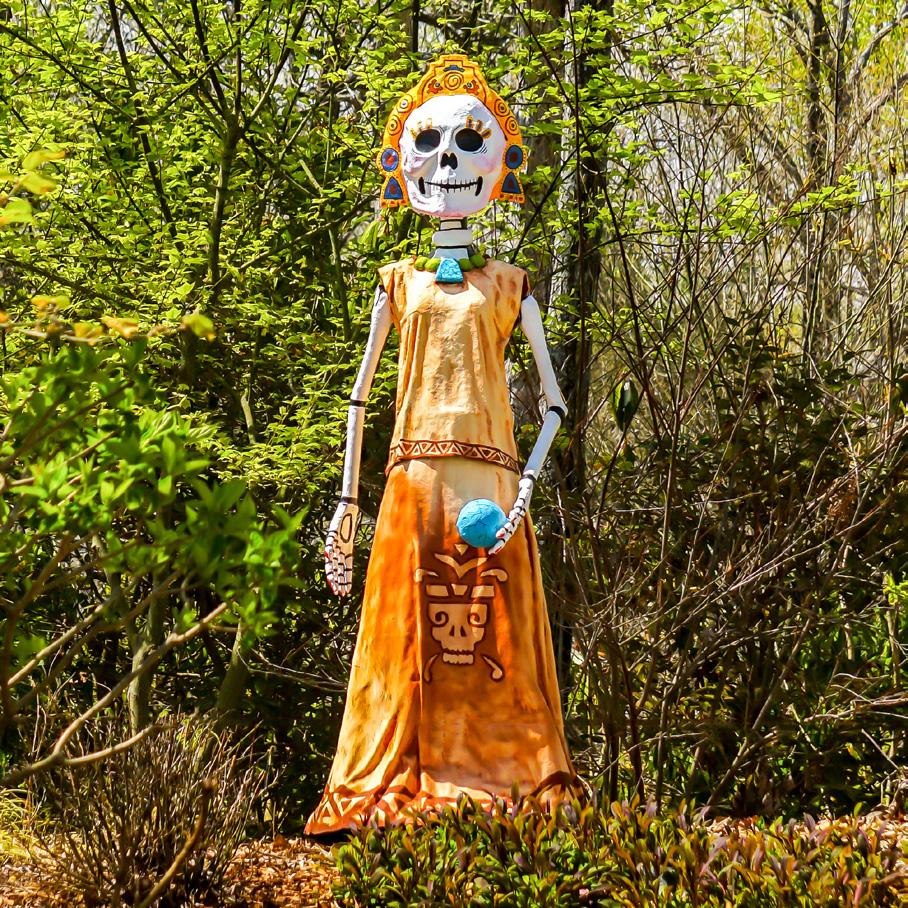
The fiberglass sculptures were created by Los Angeles artist Ricardo Soltero for an exhibit organized by Denver Botanic Gardens.
La Catrina appears as part of Dia de los Muertos (Day of the Dead) celebrations held in fall throughout Mexico, Latin America and the United States. Death is treated as a celebration of life, not a mournful commemoration.
Originally created with ties to political satire by Mexican artist Jose Posada in 1913, Catrin/Catrina portrayed an elegantly dressed man/woman and represented the contrast between upper and lower classes. The image parodied the upper class and its desire to dress more like Europeans and adopt European aristocratic culture. The image of La Catrina ultimately enabled the ability to laugh at death itself. Today, La Catrina reflects people from all walks of life.
The exhibit features sculptures depicting Mexican artists, including the well-known Frida Kahlo.
Two other themes are woven into La Calavera Catrina. The first is that of butterflies which represent change and transformation in Mexican culture. Monarch butterflies, which migrate from Canada and the United States to Mexico to overwinter, are found on one of the costumes of a La Catrina figure. Because this migration occurs in the fall near the Day of the Dead, monarchs have come to represent the return of the souls for the celebration of the holiday.

Color also plays an important part in the exhibit. The Mexican Marigold, with its large, 3-inch-wide bright orange and yellow flowers, evokes the sun. In Aztec culture, the sun guided the souls of those who had passed on. The petals of the marigold were used to line the pathway of departing souls and are still used today in Day of the Dead celebrations. For the exhibit, the Garden has grown Mexican Marigold from seed and has planted them in various annual displays around the La Catrina sculptures.
La Calavera Catrina continues through August 27.
Through Sunday, Aug. 27
The exhibition, organized by Denver Botanic Gardens, features larger-than-life sculptures of La Catrina by artist Ricardo Soltero.
May – August
Topics include houseplants, garden tours, blanket making and more.
First Saturday, May – October, 5 – 8 p.m. Enjoy a signature cocktail or other cool beverage while listening to live music, playing lawn games and strolling the garden.
Second Friday, May - July
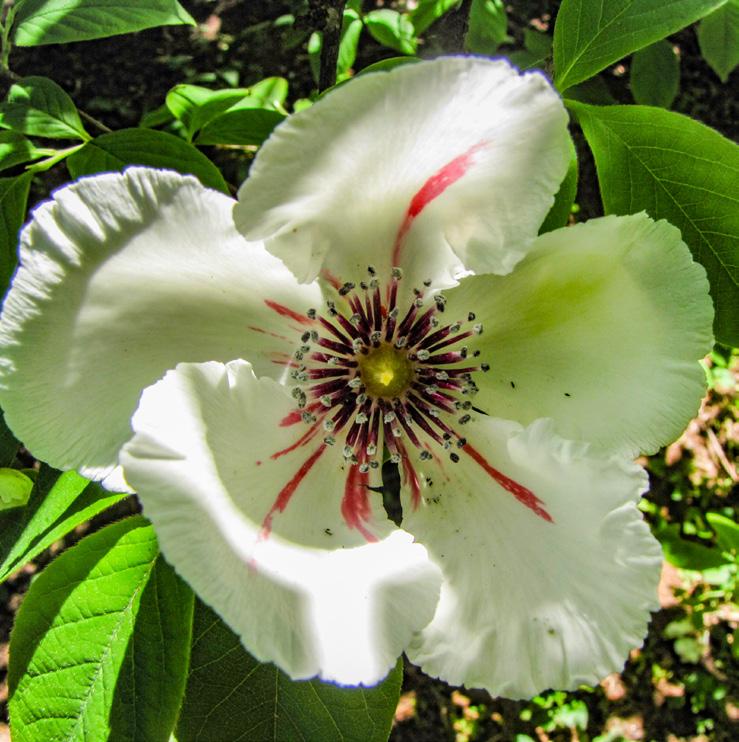
Silky Camellia, Stewartia malacodendron, isn’t actually a Camellia at all! It does, however, belong to the same plant family, Theaceae, as do the many well-known evergreen Camellia species.
Most Stewartia species are from Asia except two in North America, Stewartia ovata and Stewartia malacodendron. S. ovata is a higher elevation, mountainous species making it difficult to grow in most urban or garden settings in the Southeast. S. malacodendron is the more heat-tolerant form growing in limited populations from Virginia, south to Florida and west to Texas.
Silky Camellia is a relatively small tree growing 10 to 15 feet tall ultimately, making it a great tree for smaller spaces. The flowers of S. malacodendron typically make their appearance in late May to June and are really the star of the show. The blooms feature large white petals with ruffled edges and bright purple stamens that really make the bloom pop. They
resemble some Camellia flowers and measure about 3 inches across.
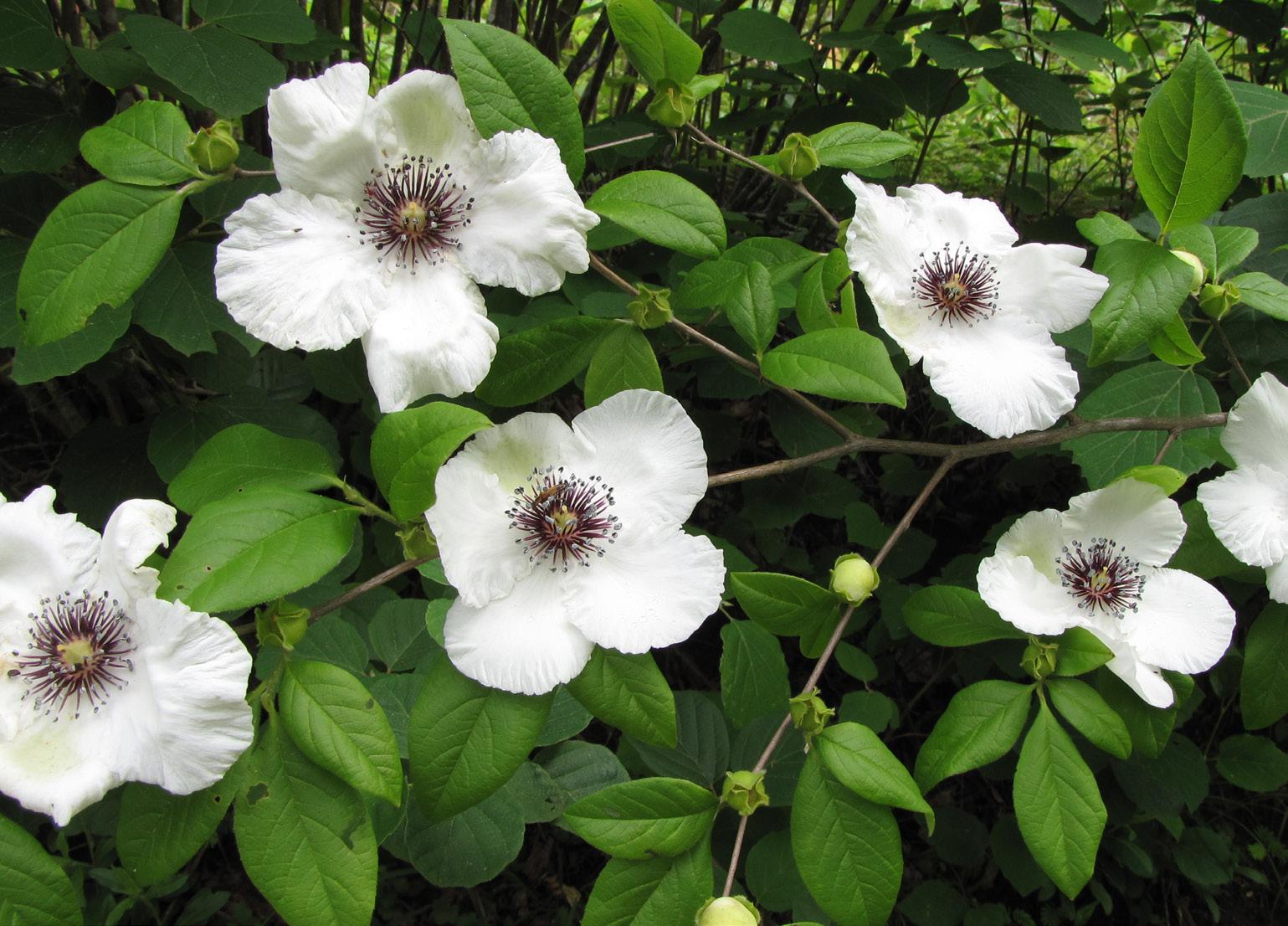
On some specimens the purple stamen color extends into the petals creating stunning pink stripes. Another bonus of this plant is that it blooms at each node on its branches, creating a wonderful visual effect of the whole tree exploding into bloom.
To see Silky Camellia in bloom, visit the promenade at the Gainesville Garden.
Ethan Guthrie Horticulture ManagerCome dressed as a favorite fairytale character (fairies, dragons, knights, princess, witches and wizards, for example) and enjoy fun, magical activities for the entire family. Then, at 11 a.m., join the Fairytale Parade starting in the children’s garden and proceeding through the garden to the sound of music while being showered in bubbles.
Wednesdays, May – August, 10 a.m. – Noon
Enjoy storytelling and a children’s sensory bin with the little ones in the children’s garden.
First Saturday, May – October, 11 a.m. Enjoy special guests and performances with the little ones.
Monday – Friday, July 17 – 21, 24 - 28
Join a fun creative environment designed to excite kids about the science and magic of nature with STEM-based activities.
Contributing and above
Tuesday, May 2, 6 – 9 p.m.
All members
Wednesday, May 3, 6 - 9 p.m.
Members are invited to special evenings for celebrating the Garden. Explore the enormous sculptures of Trolls: Save the Humans by Thomas Dambo, and enjoy live music, entertainment and fun interactive activities showcasing the Garden’s programs in horticulture, conservation, education, community outreach and more.
Member Summer Evening
Monday, July 10, 5 - 9 p.m.
All members are invited to enjoy a special evening in Atlanta! Tour Trolls: Save the Humans by Thomas Dambo, enjoy live music, surprise entertainment and familyfriendly activities. Details at atlantabg. org/member-events.
& ABOVE
Gainesville: Monday, May 15, 6 - 9 p.m.
Atlanta: Monday, Aug. 14, 6 - 9 p.m.
Supporting-level members and above are invited to spend a delightful evening under the treetops, mingle with fellow members, indulge in delicious hors d’oeuvres and libations, and listen to a live performance
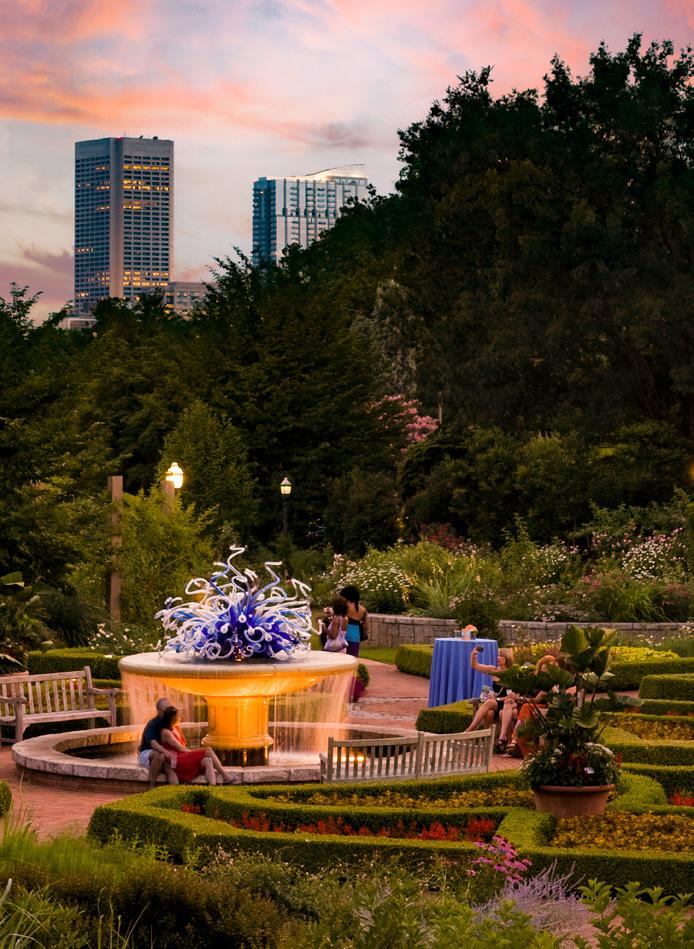
404-888-GROW planthotline@atlantabg.org
QUESTIONS? Call 404-591-1539 or email membership@atlantabg.org
Paula White has been honored with the 2022 Volunteer of the Year Award.
by outstanding musicians. Invitations will be mailed. To upgrade to the Supporting level or above, call 404-591-1544.
CONTRIBUTING & ABOVE
Gainesville; June 14, 6 - 7:30 p.m. Atlanta: Monday, July 24, 5:30 - 8 p.m. Contributing-level members and above may enjoy light refreshments and behind-thescenes staff presentations. Look for an email with RSVP information and details. To upgrade to the Contributing level or above, call 404-591-1544.
My spring bulbs were beautiful this year, but now the foliage is looking unattractive. Should I cut it off?
No, bulb foliage should be allowed to stay. It feeds the bulbs as they prepare to go dormant. Instead of trimming the foliage, surround it with other plants to hide it or roll the foliage down and use rubber bands to hold it in place.
Since beginning her service with the Garden in 2009, White has led tours as a docent guide, gardened with the horticulturists, greeted guests in the visitor center, taught visitors at discovery stations about plant collections and conservation work, and helped at numerous events such as Garden Lights, Holiday Nights, Goblins in the Garden and Concerts in the Garden.
Her biggest impact, however, has been in leadership roles for the Gardens for Connoisseurs Tour, the Spring Gardening Symposium, the Plant Explorers Auction and the Garden’s Flower Show.

“We are so fortunate to have her support in the Advancement Department,” said Melissa Roberts, Senior Development Manager. “Her kind and generous spirit make her such a pleasure to work with and a treasure for the Garden.”

Go behind the scenes at the Garden with PlantIntel, the annual publication dedicated to sharing staff stories of “science in action.” The new issue highlights the ever-growing use of technology in horticulture and plant conservation work. Read the magazine online at issuu.com/atlantabotanicalgarden or pick up a copy in the Hardin Visitor Center.
